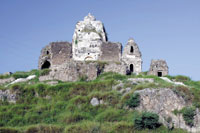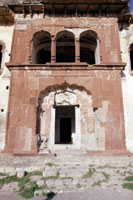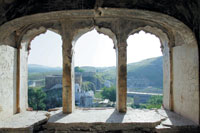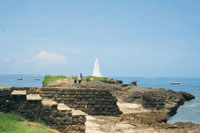


























|
rebuilding
Where Shiva wept...
If all goes well, Ketas will
yet again thrive as a pilgrimage site
By Salman Rashid
For those who believe, the pond at
Ketas (near the town of Choa Saidan Shah in Chakwal district) was formed by
his tears when an inconsolable Shiva wept for his dead wife Sati. And so the
pond is sacred to the Hindus. Among the tirathas in the subcontinent, Ketas,
because of its connection with Shiva, ranks among the holiest. In this pond
the devout tell their children to strew their ashes after they die, here they
long to visit in their lifetimes. And when they do come, they carry away
bottles of the sacred water – the magical talisman to cure all ills, to
banish all worldly cares, to cleanse all impurities of body and soul.
Africa's
little Italy
From sandy beaches to
architecture, everything about Malindi is European
By Durdana Ali Malik
Of the many memorable occasions
during my visit to Africa, the most atypical was the discovery of Malindi
Town popularly known as Kenya's version of Italy. In the North of Mombasa, a
short flight on a 12 seater plane of dubious lineage, flying over acres of
sisal plantations landed us shakily on a very 'home made' airstrip. Flashes
of the famous movie Out of Africa passed before my eyes, but I ain't no Meryl
Streep and no Robert Redford waited for me. So gathering our assorted bags,
my party and I boarded a shuttle to Hemingways, one of the area's popular
resorts. We drove through wild countryside, stopped to drink coconut water
directly from coconuts, and arrived at the white sands of Watamu Bay's
crystal waters. Vasco de Gama passed this way and erected a tower on the
headland to mark his progress. A beautiful and interesting place, one comes
across coral reefs to marvel at and some ruins of ancient Gede to be
explored. At the resort, we admired the heaps of marlin and sailfish, an easy
game here. We were delighted to discover that the likes of Bill Gates, Naomi
Campbell and a host of other international celebrities stayed at this place.
Way to go Lahoris! One of the most fascinating facts about Malindi was that
it was the inspiration for Ernest Hemingway's acclaimed masterpiece The Old
Man and the Sea.
rebuilding
Where Shiva wept...
If all goes
well, Ketas will yet again thrive as a pilgrimage site
By Salman
Rashid
For those who believe, the
pond at Ketas (near the town of Choa Saidan Shah in Chakwal district) was
formed by his tears when an inconsolable Shiva wept for his dead wife Sati. And so the
pond is sacred to the Hindus. Among the tirathas in the subcontinent, Ketas,
because of its connection with Shiva, ranks among the holiest. In this pond
the devout tell their children to strew their ashes after they die, here they
long to visit in their lifetimes. And when they do come, they carry away
bottles of the sacred water – the magical talisman to cure all ills, to
banish all worldly cares, to cleanse all impurities of body and soul.
his tears when an inconsolable Shiva wept for his dead wife Sati. And so the
pond is sacred to the Hindus. Among the tirathas in the subcontinent, Ketas,
because of its connection with Shiva, ranks among the holiest. In this pond
the devout tell their children to strew their ashes after they die, here they
long to visit in their lifetimes. And when they do come, they carry away
bottles of the sacred water – the magical talisman to cure all ills, to
banish all worldly cares, to cleanse all impurities of body and soul.
Long before the Shaivites
took over this site and raised their temples to Shiva, Ketas was sacred to
other religions. We do not know the gods they worshipped here five thousand
years ago, but since the spread of Buddhism, Ketas was a great and bustling
monastery. In 631 Xuanzang, the Chinese Buddhist master, travelled from
Taxila to the town of Singhapura in the midst of mountains.
We now know from the work
of great archaeologists that Singhapura is today marked by the village of
Dulmial a kilometre and a half to the north of Ketas. Having billeted himself there,
the pilgrim visited the monastery and the stupa. He was horrified to see it
deserted and without priests. The stupa, so Xuanzang tells us, had been
raised by Asoka and was at the time of his visit in ruins.
kilometre and a half to the north of Ketas. Having billeted himself there,
the pilgrim visited the monastery and the stupa. He was horrified to see it
deserted and without priests. The stupa, so Xuanzang tells us, had been
raised by Asoka and was at the time of his visit in ruins.
Only a hundred years before
the pilgrim's visit, Punjab had been laid waste by the barbaric Huns under
Mehr Gul (Mihiragula) and flourishing Buddhism had suffered considerably.
This setback to the prevalent religion permitted Hinduism to go on the
ascendant. It was then that the Shiva legend replaced earlier Buddhist
legends the same way as even older tales were taken over by the Buddhists a
thousand years earlier.
In the five hundred years
of peace between the overthrow of the Huns and the invasions of the Turks,
the Salt Range was adorned with a number of temples by the Hindu Shahya
rulers of Punjab and Pukhtunkhwa. At Ketas they raised a complex because
there stand three edifices that can clearly be dated to the late 11th
century. Built of dark calciferous limestone, they stand apart from the stone
and mortar buildings of later times.
Overlooking the sacred pond
is the main Shaivite temple and with it an arc of ancillary buildings.
Adjacent to the main temple is the fortress like residence of Sardar Hari
Singh Nalwa that he ordered when he governed the Salt Range in the early
years of the 19th century.
Following the
transmigration of partition, Ketas was laid waste a second time. The temples
were desecrated, Nalwa's palace destroyed, its rafters removed to build other homes. In fact,
the roofs of most of the buildings were dismantled and the material used
elsewhere. In the mid-1980s a half-hearted attempt at restoration was made
when a group of pilgrims were to visit from India. This was restricted to
white-washing of a couple of buildings and no more.
Nalwa's palace destroyed, its rafters removed to build other homes. In fact,
the roofs of most of the buildings were dismantled and the material used
elsewhere. In the mid-1980s a half-hearted attempt at restoration was made
when a group of pilgrims were to visit from India. This was restricted to
white-washing of a couple of buildings and no more.
So aggressive was the
neglect that for a time it seemed Ketas had been consigned to doom. But
miracles never cease in this land and the Punjab Archaeology Department (PAD)
has recently acquired the temple complex from the federal government. Among
other things Hari Singh's palace has been fixed with doors that had long ago
been wrenched out to adorn other homes and its roofs are being redone.
That is a good beginning
because PAD has great plans in store: Ketas, if all goes well, will yet again
thrive as a pilgrimage site. It will yet be pulled back from the brink.
Africa's
little Italy
From sandy
beaches to architecture, everything about Malindi is European
By Durdana
Ali Malik
Of the many memorable
occasions during my visit to Africa, the most atypical was the discovery of
Malindi Town popularly known as Kenya's version of Italy. In the North of Mombasa, a short
flight on a 12 seater plane of dubious lineage, flying over acres of sisal
plantations landed us shakily on a very 'home made' airstrip. Flashes of the
famous movie Out of Africa passed before my eyes, but I ain't no Meryl Streep
and no Robert Redford waited for me. So gathering our assorted bags, my party
and I boarded a shuttle to Hemingways, one of the area's popular resorts. We
drove through wild countryside, stopped to drink coconut water directly from
coconuts, and arrived at the white sands of Watamu Bay's crystal waters.
Vasco de Gama passed this way and erected a tower on the headland to mark his
progress. A beautiful and interesting place, one comes across coral reefs to
marvel at and some ruins of ancient Gede to be explored. At the resort, we
admired the heaps of marlin and sailfish, an easy game here. We were
delighted to discover that the likes of Bill Gates, Naomi Campbell and a host
of other international celebrities stayed at this place. Way to go Lahoris!
One of the most fascinating facts about Malindi was that it was the
inspiration for Ernest Hemingway's acclaimed masterpiece The Old Man and the
Sea.
popularly known as Kenya's version of Italy. In the North of Mombasa, a short
flight on a 12 seater plane of dubious lineage, flying over acres of sisal
plantations landed us shakily on a very 'home made' airstrip. Flashes of the
famous movie Out of Africa passed before my eyes, but I ain't no Meryl Streep
and no Robert Redford waited for me. So gathering our assorted bags, my party
and I boarded a shuttle to Hemingways, one of the area's popular resorts. We
drove through wild countryside, stopped to drink coconut water directly from
coconuts, and arrived at the white sands of Watamu Bay's crystal waters.
Vasco de Gama passed this way and erected a tower on the headland to mark his
progress. A beautiful and interesting place, one comes across coral reefs to
marvel at and some ruins of ancient Gede to be explored. At the resort, we
admired the heaps of marlin and sailfish, an easy game here. We were
delighted to discover that the likes of Bill Gates, Naomi Campbell and a host
of other international celebrities stayed at this place. Way to go Lahoris!
One of the most fascinating facts about Malindi was that it was the
inspiration for Ernest Hemingway's acclaimed masterpiece The Old Man and the
Sea.
Venturing downtown we were
amazed at the the 'Italianness' of the town. The whole atmosphere of Malindi
is no different from any small Italian town -- or at least that is what I
felt. The town also boasts of some of the best pizza, pasta and ice-cream in
the world. Greet a kid on the streets of Malindi and he will reply mostly in
Italian. Most signage is in Italian, and if it wasn't for the typical African
tourist shops, you couldn't tell if it was Africa or Italy.
I wouldn't want to mess
with sensitive information, but I was told that Malindi was the place chosen
by the Italian mafia once they flee their homeland. Malindi was a safe haven
for them, thanks to the hospitality of the local Muslim community and the
poverty. They built European style resorts, luxury villas and boats
transforming a poor albeit rustic beach town into a European one. And nobody
is complaining. Italians own more than 2,500 properties while the number of
Italian residents in Malindi town and its environs, is estimated to be
slightly over 3,000. Despite its reliance on tourism, Malindi still has some
interest as a Kenyan town with an ancient history and a few places of
interest other than its beach and reef. An interesting old Swahili quarter,
one or two ruins, a busy market, shops, hotels and plenty of lodgings -- all
compensate for typical tourist boutiques, beauty salons and real estate
agencies.
|Home|Daily
Jang|The
News|Sales
& Advt|Contact
Us|
|
BACK
ISSUES






|


































